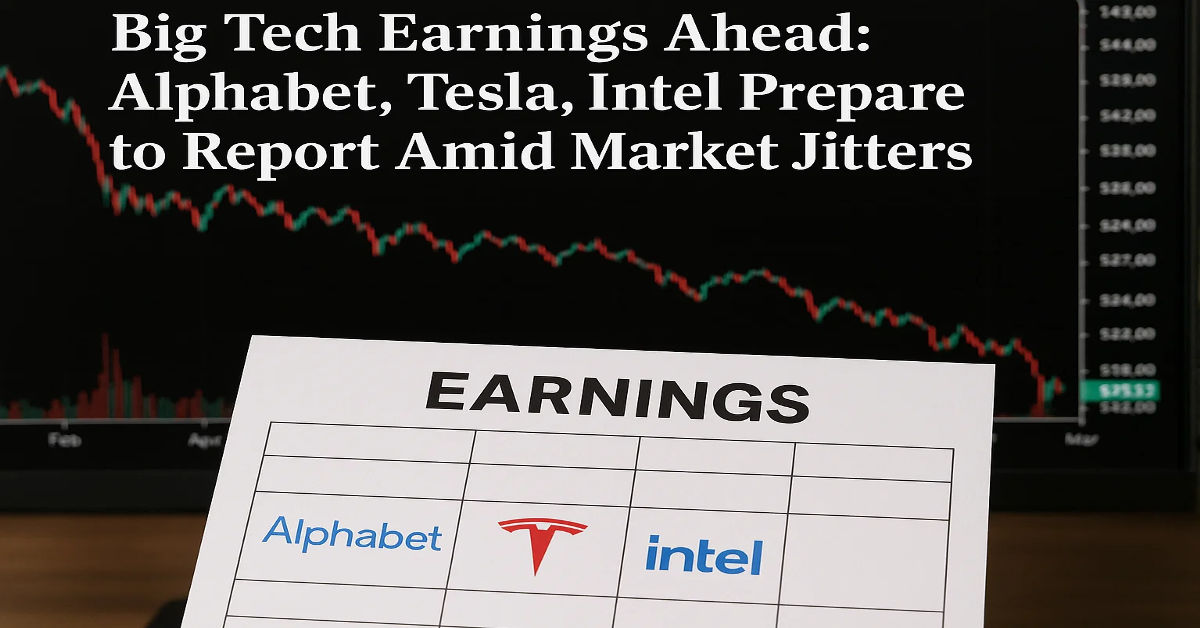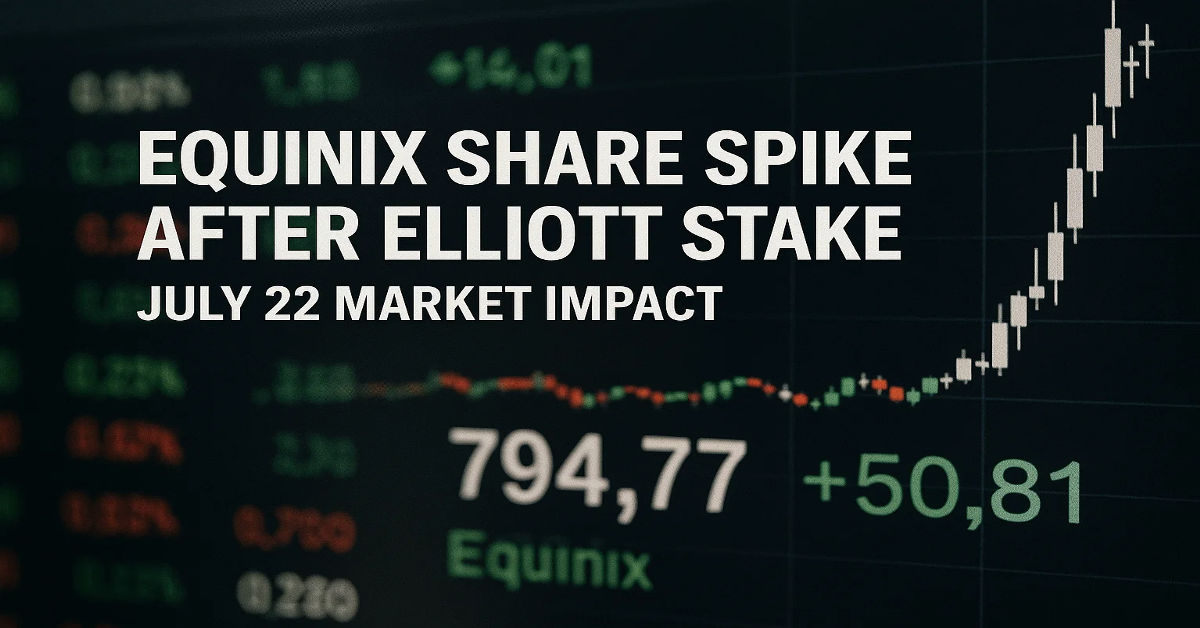
As the second-quarter earnings season reaches its peak, anticipation builds around a key trio of tech giants: Alphabet, Tesla, and Intel. These companies are not only pivotal players in the technology sector they also act as market barometers, influencing investor sentiment, sector performance, and even monetary policy reactions. With economic signals remaining mixed and tech valuations running high, Wall Street is bracing for a pivotal moment.
This earnings week isn’t just about raw numbers. It’s about narratives—about how these firms are positioning themselves in an era of AI acceleration, EV disruption, and semiconductor resurgence. Let’s break down what to expect from each, how they affect broader market dynamics, and what it all means for investors and policymakers alike.
Alphabet (GOOGL): Growth in the Shadows of Regulation and AI Wars
Alphabet, Google’s parent company, is scheduled to report its Q2 earnings, and analysts expect moderate but consistent growth driven by digital advertising recovery and strong cloud momentum. In Q1, Alphabet posted a 15% increase in Google Cloud revenue, signaling potential upside in its enterprise-facing business. However, the real attention is on:
🔹 Ad Revenue Stability
- YouTube and Search are expected to see renewed strength as advertisers return post-budget cuts.
- Growth in international markets could balance out domestic softness.
🔹 AI Integration & Gemini Progress
Alphabet has bet heavily on Gemini, its flagship large language model intended to rival OpenAI’s ChatGPT. Investors want clarity on monetization, partnerships, and deployment across core Google products.
🔹 Regulatory Pressures
Alphabet faces mounting antitrust scrutiny in the U.S. and Europe. The ongoing DOJ antitrust case could shape future revenue streams from ad tech, especially if divestitures are mandated.
Investor Insight: Alphabet’s guidance on AI adoption, capital expenditures, and legal liabilities will carry as much weight as its topline numbers.
Tesla (TSLA): Margins Under Pressure, Musk’s Master Plan 3 in Focus
Tesla remains one of the most polarizing stocks on the market. Beloved by retail investors and increasingly questioned by institutional analysts, Tesla’s Q2 results come at a crossroads. Vehicle deliveries hit a record this quarter, but price cuts have narrowed the company’s once-lucrative margins.
🔹 Vehicle Sales vs. Profitability
- Q2 saw Tesla deliver over 440,000 vehicles, but the average selling price has declined.
- Gross margins may fall below 18%, well below their peak of above 25% in 2022.
🔹 AI, Robotaxi, and Autonomy
Musk has teased a full unveiling of the robotaxi platform in August. Investors expect early details on software development, fleet models, and AI strategy. This aligns with Musk’s Master Plan Part 3, which outlines Tesla’s long-term vision beyond cars.
🔹 Production and Supply Chain
Tesla’s factories in Berlin, Shanghai, and Texas continue ramping. The focus will also be on battery innovations and supply chain efficiency.
Tesla’s evolving ecosystem resembles the kind of disruptive tech mindset driving innovation in companies like Revo Technologies in Murray, Utah, showing how vertically integrated models are gaining momentum across industries.
Investor Insight: Tesla’s narrative is shifting from EV dominance to AI, autonomy, and energy. But investors are still scrutinizing today’s margins as much as tomorrow’s moonshots.
Intel (INTC): Comeback Campaign Faces Its Moment of Truth
Among the three, Intel has the most to prove. Once the undisputed leader in semiconductor design and fabrication, Intel has struggled in the face of growing competition from AMD, Nvidia, and Apple’s custom chips.
However, CEO Pat Gelsinger’s multi-year transformation plan is gaining traction. The company’s Q2 report is expected to highlight three critical areas:
🔹 AI Hardware Demand
Intel recently unveiled its Gaudi 3 AI chips, designed to challenge Nvidia’s dominance in the AI acceleration space. Investors want to see early traction and customer feedback.
🔹 Foundry Strategy
Intel Foundry Services (IFS) is central to Gelsinger’s strategy. Building a U.S.-based, third-party fab capacity would align Intel with broader geopolitical goals around semiconductor independence.
🔹 Consumer & Enterprise PC Rebound
With global PC shipments stabilizing, Intel may see stronger-than-expected demand in its consumer segment, particularly with its Meteor Lake and Lunar Lake architectures.
Investor Insight: Intel must deliver more than hope—it needs execution. AI relevance and foundry success are critical long-term narratives, but current revenue growth is still the real test.
Market Impact: Why These Earnings Matter Beyond Tech
These three earnings reports will have macro-level consequences, not just for the S&P 500 and Nasdaq, but also for policy, trade, and consumer behavior. Consider the following:
- A strong quarter from Big Tech could fuel further market rallies, especially with investors eyeing rate cuts in late 2025.
- Weak guidance could revive recession fears, especially with the Federal Reserve still concerned about wage inflation and asset bubbles.
- These firms shape global trade and tech policies—especially important as U.S.-EU trade negotiations heat up ahead of potential August tariffs.
The market showed early signs of tension in futures activity this week. As noted in the S&P 500 and Nasdaq futures report, investors are balancing cautious optimism with the potential for tech earnings to either validate or unravel current valuations.
Conclusion
As earnings season peaks, the financial world turns its full attention to the performance of three of the most influential tech companies Alphabet, Tesla, and Intel. These firms not only drive innovation in their respective industries but also serve as economic indicators that shape market sentiment across the globe. From Alphabet’s AI and advertising dominance to Tesla’s EV disruption and Intel’s semiconductor revival, each earnings report tells a bigger story about the direction of technology and global business.
Investors, analysts, and policymakers will be closely watching key performance metrics, future guidance, and strategic updates. Whether it’s Alphabet’s progress in monetizing AI through Gemini, Tesla’s margin resilience amid aggressive price cuts, or Intel’s turnaround efforts in chip manufacturing, these reports could serve as turning points. The outcomes may either validate the tech sector’s recent rally or prompt a recalibration of valuations.
These earnings go beyond numbers—they reflect the pace of digital transformation, investor confidence, and even national economic strategies. As innovation accelerates and competition intensifies, the insights gained from this quarter will help define the next phase of Big Tech leadership. For market participants, staying informed on these reports is essential, not optional. The ripple effects could be felt far beyond Wall Street, influencing everything from global supply chains to AI policy and energy investment. One thing is clear: the future of tech and possibly the market hangs in the balance this earnings week.
FAQs
1. Why are Alphabet, Tesla, and Intel’s earnings reports so important to the stock market?
These companies are considered bellwethers in their respective industries Alphabet in digital advertising and AI, Tesla in EV and autonomy, and Intel in semiconductors. Their earnings offer insight into tech sector health, consumer trends, and enterprise spending. A strong performance can boost market sentiment, while weak guidance may signal broader economic challenges. Investors watch them closely to assess potential market direction.
2. What should investors look for in Alphabet’s Q2 earnings?
Investors will focus on Google’s advertising revenue, cloud segment growth, and updates on Gemini, Alphabet’s AI platform. Regulatory risk remains a concern, especially with ongoing antitrust scrutiny in the U.S. and Europe. Revenue diversification and AI monetization strategies will likely influence how analysts react. Any surprises in operating costs or capital expenditures may also affect share performance.
3. How do Tesla’s price cuts affect its profit margins?
Tesla has implemented multiple price cuts globally to remain competitive, particularly in China and the U.S. While this has led to increased delivery volumes, it has significantly compressed its gross margins. Investors will closely evaluate how Tesla balances affordability with profitability. The company’s long-term growth hinges on its ability to scale while maintaining reasonable margins.
4. What’s the significance of Tesla’s robotaxi plans for investors?
Tesla’s robotaxi program is central to Elon Musk’s long-term vision of full self-driving (FSD) and transportation disruption. Investors view it as a potential multi-billion-dollar revenue stream, but it also carries regulatory, technological, and ethical hurdles. Musk has teased a full reveal in August, making the current quarter crucial for laying groundwork. Concrete updates on FSD progress and fleet development may heavily influence investor confidence.
5. How is Alphabet leveraging AI to compete in the current tech landscape?
Alphabet is aggressively integrating AI across its ecosystem, including Search, Google Workspace, and YouTube. Its Gemini AI model competes directly with OpenAI’s ChatGPT, and investors want to see measurable returns on these initiatives. The company’s AI push is also key to maintaining its dominance in search as competition from AI chatbots rises. Strong AI adoption could offset slowing ad revenue in the long term.
6. What does Intel need to deliver in this quarter to convince investors?
Intel must show tangible progress in its turnaround plan, particularly in its foundry business and AI chip development. Gaudi 3 chips are expected to compete in the AI hardware race, but revenue contributions are still limited. Investors also expect recovery in PC and data center segments after a tough 2023. Meeting or beating guidance could restore confidence in Intel’s transformation efforts.
7. Are Big Tech stocks overvalued going into this earnings season?
Valuations for companies like Alphabet and Tesla have rebounded significantly in 2024, which raises concerns of overvaluation if earnings fail to impress. However, some analysts argue that strong AI adoption and improving macro trends justify higher multiples. Intel remains relatively undervalued due to its lagging fundamentals. Ultimately, each company will be judged on earnings performance and forward guidance.
8. How do these earnings affect retail investors and traders?
Retail investors often react sharply to Big Tech earnings due to their influence on indices like the S&P 500 and Nasdaq. Positive earnings can trigger buying momentum and FOMO, while misses can cause abrupt sell-offs. These companies also shape sentiment in adjacent sectors like software, automotive, and semiconductors. Traders may also use earnings volatility to profit through short-term plays or options strategies.
9. What macroeconomic factors could influence these earnings results?
Several factors may impact Q2 performance, including consumer spending, inflation trends, and global demand for technology. Exchange rates, supply chain stability, and energy prices could also play a role. The Federal Reserve’s stance on interest rates continues to affect borrowing costs and business investment. Tech companies that demonstrate resilience amid these pressures are more likely to win investor favor.
10. Can Big Tech earnings influence policy decisions or regulation?
Yes, large tech earnings often attract the attention of policymakers, especially when profit margins soar amid economic inequality debates. Alphabet and Tesla, in particular, are under increasing regulatory scrutiny for privacy, labor, and antitrust issues. Strong earnings can bolster their lobbying efforts but may also accelerate calls for regulation. Intel’s role in national chip strategy also ties its performance to trade and security policies.









































































































































































































































